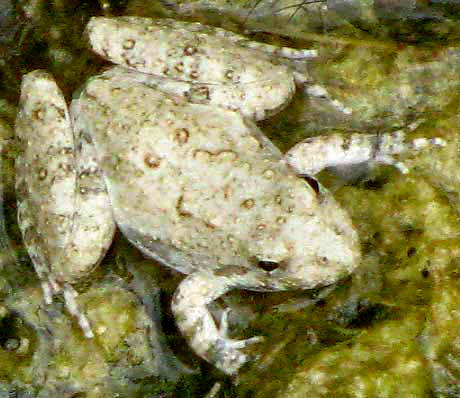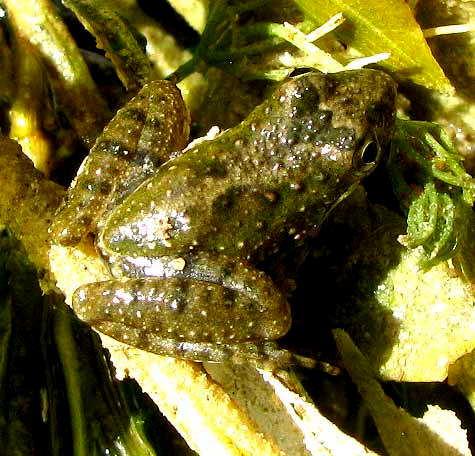Excerpts from Jim Conrad's
Naturalist Newsletter
from the September 9, 2012 Newsletter issued from the valley of the Dry Frio River in northern Uvalde County, southwestern Texas, on the southern border of the Edwards Plateau; elevation ~1750m (~5750 ft); N29.62°, W99.86°; USA
CRICKET FROGS
Behind the cabin in the Dry Frio River's streambed there's a certain place where sometime in the past floodwater deposited a bar of rounded, cherty pebbles and cobbles. Now water disappears into it and filters to the other side. As I approached a calm, algae-scummed pool where water disappeared into the sediment numerous tiny, gray critters I assumed to be grasshopper nymphs hopped out of my way like gray popcorn jumping from the streambed. But when finally I got a closer look, the popcorn turned out to be frogs, lots of them, tinier than you think a frog ought to be. Below you can see one, about an inch long (2.5cm):

With such warty skin at first I thought it was a baby toad, but atop the head behind the eyes there's no hint of a toad's bumpy parotoid glands and cranial crests. Often tiny frogs turn out to be treefrogs, but treefrogs normally have rounded pads on their toes, and this frog's toes don't have pads. Cricket frogs are tiny, but the cricket frogs I know are darker with conspicuous dark bands on the legs, and are often greenish.
So, referring to distribution maps in my Audubon field guide to reptiles and amphibians, I made a list of the eleven or twelve frog species possibly found in this part of arid southwestern Texas. Then through the process of elimination I came to this verdict: Blanchard's Cricket Frog, which is a subspecies of the Northern Cricket Frog. It's ACRIS CREPITANS ssp. BLANCHARDI. Apparently our southwestern Texas race is much paler than more northern individuals of the same species. Certainly here their color camouflages them well against the Dry Frio's white limestone streambed.
There's another cricket frog species I thought it might be, the Southern Cricket Frog, Acris gryllus, but it extends no farther west than Louisiana. Our Northern Cricket Frog species is found from just west of here, a bit across the border in Mexico, to Michigan and southern New York. I read that the Northern Cricket Frog is one of North America's two smallest vertebrates.
Cricket frogs are members of the Treefrog Family, so my opinion that treefrogs should bear round pads on their toes wasn't exactly right. Cricket frogs can be thought of as less tree-oriented but more aquatic treefrogs who don't need the adhesive toe pads in their watery habitats. Though we have plenty of them here, Blanchard's Cricket Frogs are listed as endangered in Wisconsin and threatened in Michigan, where since the late 1970s there's been a significant population decline because of habitat loss and chemical contamination.
Cricket frogs get their name from the clicking, metallic, crickety sound the calling males make at breeding time.
from the August 18, 2013 Newsletter issued from the valley of the Dry Frio River in northern Uvalde County, southwestern Texas, on the southern border of the Edwards Plateau; elevation ~1750m (~5750 ft); N29.62°, W99.86°; USA
CRICKET FROG, A DARKER ONE
Last month we looked at a shallow pool choked with flowering pondweed. During this droughty summer the little Dry Frio River is just a chain of such pools separated by dry stretches of gravel and cobblestones. Now the water in our pondweeds' pool is even lower and wandering cattle have smushed the pondweed and mud together into a soggy mess. Still, the pool harbors untold numbers of tiny frogs that are quite active during hot, dry daylight hours. You can see one below:

That frog is about ¾-inch long (2cm), and besides its smallness and being active during the day, its main field marks are the dark triangle between the eyes, the dark stripes on the back thigh, and the rounded, somewhat long snout.
We've run into this species before. In Mississippi we had a different subspecies, Acris crepitans ssp. crepitans, which was reddish brown, as shown at http://www.backyardnature.net/n/09/090216cf.jpg.
This time last year, here, we ran into our current subspecies, the Blanchard's Cricket Frog, ACRIS CREPITANS ssp. BLANCHARDI, but that one was very pale, almost whitish, as you can see at the top of this page.
So, there's a lot of variation in this species, and one worries about getting the ID right. However, there just aren't many species that are this small, are active during the day, display the above field marks, and occur in southwestern Texas. The whitish one found last year suggests a Gray Treefrog, but they're larger and bear conspicuous, round toe pads.
Cricket frogs are known to migrate after rains for distances of up to 4/5ths of a mile (1.3km), looking for new ponds. When you see how many occupy the little pools along the Dry Frio you understand why migrating might be a good idea. I guess that most cricket frogs that migrate away from the river simply die, which certainly is one way to lower a pool's population density to sustainable levels.
Over much of their distribution, along with many other amphibian species, cricket frogs are disappearing completely from large areas. I'm thankful that along the Dry Frio, on rare rainy nights, we can still hear the crickety calls of these little beings.